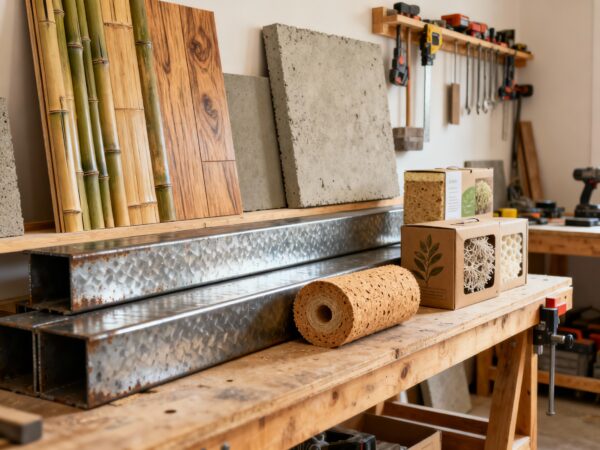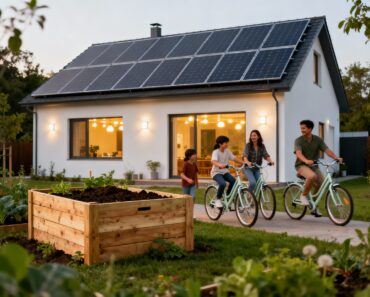As awareness of environmental impact grows, homeowners increasingly seek sustainable options for repairs and renovations. Choosing eco-friendly materials not only reduces your carbon footprint but also enhances indoor air quality, energy efficiency, and long-term durability. This guide explores the best sustainable building materials available in 2025, highlighting their benefits and applications for eco-conscious home improvements.
What Makes a Material Eco-Friendly?
Eco-friendly materials are those that minimize environmental harm across their lifecycle— from extraction and production through use and disposal. Key attributes include:
-
Renewable or recycled content
-
Low embodied carbon or carbon-negative properties
-
Durability and recyclability
-
Non-toxic (low or zero VOCs)
-
Energy-efficient properties
-
Minimal waste generation
Selecting materials with certifications like FSC, GreenGuard, or Cradle to Cradle ensures accountability in sustainability claims.
Top Eco-Friendly Materials for 2025
1. Bamboo
Rapidly renewable and strong, bamboo is an excellent alternative to hardwood. It’s widely used in flooring, cabinetry, and furniture, with a carbon sequestration benefit as it grows quickly and fixes carbon efficiently.
2. Hempcrete
Hempcrete is a bio-composite made from the woody core of hemp plants mixed with lime. It’s lightweight, breathable, and naturally pest-resistant. Hempcrete absorbs CO₂ as it cures, making it carbon-negative. It provides excellent thermal and acoustic insulation, reduces energy needs, and enhances indoor air quality.
3. Recycled Steel
Steel is infinitely recyclable and using recycled steel drastically reduces the need for new mining and energy-intensive production. It’s highly durable, used structurally and decoratively, and helps lower greenhouse gas emissions in renovation projects.
4. Reclaimed Wood
Reclaimed timber from old barns, factories, or salvaged buildings adds character while conserving forests. It’s ideal for flooring, paneling, beams, and furniture. Each piece carries history and reduces demand for new lumber.
5. Ferrock
A groundbreaking carbon-negative concrete alternative made from recycled steel dust and other byproducts. Ferrock absorbs CO₂ while curing, providing a durable, hard material suitable for structural applications like countertops, flooring, and foundations.
6. Mycelium-Based Materials
Derived from mushroom roots, mycelium products are growing in popularity. They are biodegradable, possess insulating properties, and can be molded into blocks or panels for walls, insulation, or packaging.
7. Cork
Cork is harvested sustainably from the bark of cork oak trees without harming them. It’s an exceptional natural insulator, sound absorber, and resilient flooring option with anti-microbial properties.
8. Geopolymer Concrete
Replacing traditional cement with industrial byproducts like fly ash or slag, geopolymer concrete drastically reduces CO₂ emissions. It offers high durability and thermal resistance for structural renovations.
9. Composite Boards and Panels
Made from a blend of recycled fibers and environmentally friendly resins, composites provide strong, lightweight options for cabinetry and furniture. They often have lower emissions and improved lifecycle sustainability compared to conventional wood-based products.
10. Natural Insulation Materials
Materials like sheep wool, cellulose, and hemp provide non-toxic, biodegradable insulation options that improve energy efficiency while reducing indoor pollutants.
Practical Applications for Home Repairs and Renovations
-
Flooring: Bamboo, cork, reclaimed hardwood, and recycled composite tiles reduce environmental impact while offering durability and aesthetic appeal.
-
Walls and Insulation: Hempcrete, mycelium panels, cellulose, and cork insulate efficiently and regulate humidity; geopolymer concrete provides sustainable structural options.
-
Countertops and Surfaces: Ferrock and recycled glass terrazzo introduce durable, eco-friendly materials with unique aesthetics.
-
Framing and Structural Components: Use recycled steel or mass timber (large engineered wood panels) to reduce carbon emissions while ensuring strength.
-
Paints and Finishes: Select low or zero VOC paints and finishes to improve indoor air quality.
Tips for Selecting and Using Eco-Friendly Materials
-
Evaluate the full life cycle impact of materials rather than just upfront costs.
-
Choose local materials to reduce transportation emissions.
-
Partner with suppliers committed to sustainability certifications.
-
Plan for durability to minimize future replacements.
-
Dispose or recycle waste responsibly during renovation.
-
Integrate smart design principles to complement material efficiency.
Final Thoughts
Eco-friendly home repairs and renovations are a vital step toward sustainable living and climate responsibility. The selection of materials such as bamboo, hempcrete, recycled steel, ferrock, and mycelium demonstrates how innovation meets environmental stewardship without compromising quality or style.
By choosing these sustainable materials thoughtfully and combining them with energy-efficient systems and design, homeowners contribute positively to their communities and the planet—ensuring a healthy, resilient home for generations to come.
- https://www.phdassociates.co.uk/sustainable-building-materials-in-2025/
- https://blog.chaos.com/top-sustainable-building-materials
- https://www.fjdynamics.com/fr/blog/industry-insights-65/sustainable-building-materials-481
- https://www.revalu.io/journal/50-sustainable-construction-materials-to-watch-in-2025
- https://gbc-engineers.com/news/sustainable-building-materials
- https://proptechos.com/esg/sustainable-building-materials/
- https://www.sustonable.com/en/blog/best-sustainable-materials-for-construction-in-2025/
- https://www.ecomerchant.co.uk/news/top-eco-friendly-building-materials-2025/



